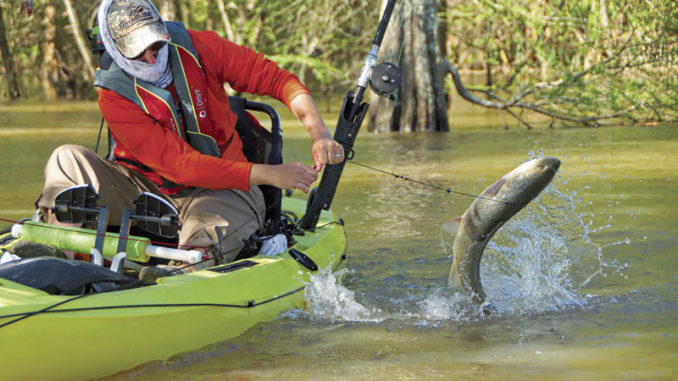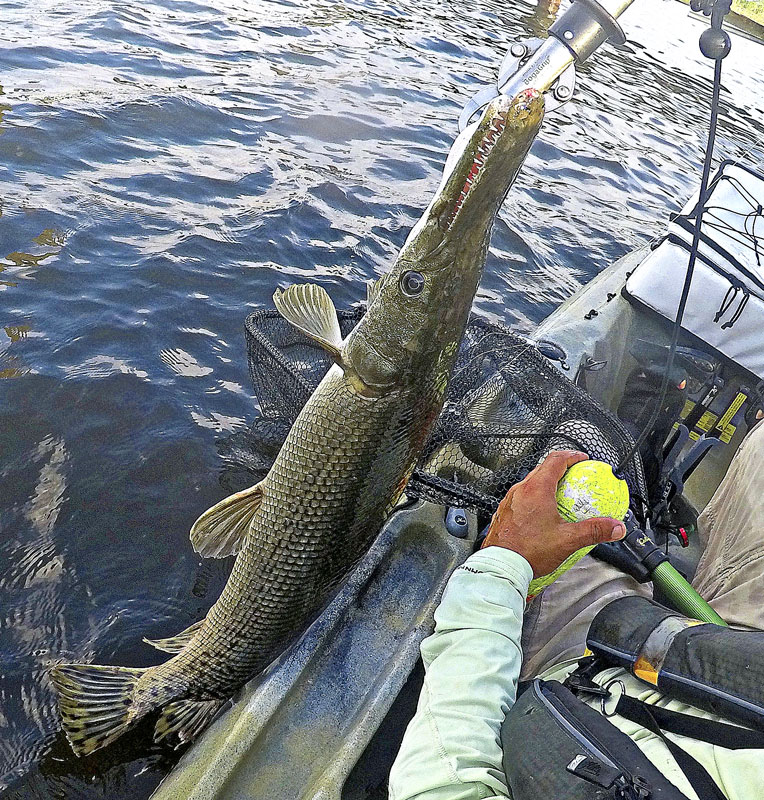
The three main species targeted by kayak fishermen in Louisiana waters are unquestionably speckled trout, reds and bass. However, whether incidental or on purpose, many other species provide great sport in a kayak and some even taste good.
Virtually no one targets choupique, aka bowfin or mudfish, but if you have ever fished for bass, you’ve more than likely thought you had a giant bass on the line, only to find out it was a lowly choupique. While some say they are good to eat, if fresh, others, like myself think they taste like a fishy cotton ball. They are tough fighters and often put on an aerial show like a bass. Catching one in a kayak is always a thrill.
Choupique have a penchant for black plastic worms, especially scented ones like Berkley Power Worms. These prehistoric fish date back more than 70 million years. If you catch a choupique, don’t make the mistake of trying to lip it like a bass or you’ll come back with a nub as they have a mouthful of sharp teeth. Bowfin are bimodal breathers; they have the capacity to breathe both water and air and are often found in backwater areas.
Garfish
Garfish are present in both freshwater and coastal brackish waters. Another ancient bimodal species, gar can thrive in waters with low dissolved-oxygen content. Louisiana waters hold four different species of gar, with the largest and most common being the alligator gar. Other species are the longnose and less-common shortnose and spotted gars. Alligator gar can be massive beasts and are known to weigh 300 pounds or better. The current Louisiana state record rod-and-reel alligator gar is 179 pounds. Garfish are fond of live or dead bait, primarily fish, but are known to sometimes strike artificial lures. Due to their extremely bony mouths, they are often hard to get solidly hooked. Anglers specifically targeting gars often use a wire leader and allow the gar to swallow the hook/bait so that it gets lodged in their throat or stomach.

Gars put up a good fight and sometimes even jump out of the water, which is quite an impressive sight, particularly if it is right next to the kayak. Handling a gar yak-side should be done with the same precautions as a shark. A strong fish-grip is recommended to get control of the fish’s mouth to avoid sustaining some nasty cuts from that jaw full of dangerous teeth.
Gar are difficult to clean, as their scaled, armored shell must be hacked or sawed into to get at the meat. However, they are all considered as providing table fare, with a particular Louisiana favorite of using the meat to make garfish balls to be used as fried patties or cooked in a gravy.
Jack crevalle
Jack crevalle are generally not usually sought-after by kayak anglers due to their poor quality as table fare. However, lack of dinner aside, catching a jack from a kayak is an awesome experience, and one you won’t soon forget. A kayak battle with a good-sized jack can easily last longer than 30 minutes. Often, the angler will be ready to throw in the towel long before the fish is ready to be brought boatside. Jacks can be found nearly anywhere one regularly fishes inshore for trout and reds. Although often caught in deep passes and bayous, it’s not uncommon to be ambushed by one in water only a foot deep.
Jacks are notorious for herding up large schools of bait and then crashing and slashing through them. Jacks are not hard to fool and readily attack a wide variety of artificial lures as well as live or natural dead bait. A jack hitting a topwater plug is one of the most-vicious strikes a fisherman can experience.
Although jacks will fight to near full exhaustion, they are hardy and will readily revive after a long battle. Move the fish back and forth in the water in an upright position until you feel it regaining strength. Since you likely won’t be keeping it to eat, using a gaff to land a jack is not advised. To handle a jack for a photo or release, wearing gloves is recommended, as you can easily be cut by their mouths, gill plates or rough areas near the tail.
Other options
Of course there are a wide variety of other species in Louisiana to target by kayak that provide great sport and a delicious meal. Catfish, bream and crappie are additional freshwater fish that are a blast to catch from the ‘yak. Other saltwater species like sheepshead, black drum and flounder can be specifically targeted.
If you’re looking for a change of pace and a chance to increase your kayak fishing skills, step out of your comfort zone and try your hand at catching some of the less popular fish species Louisiana has to offer. You’ll be glad you did.

